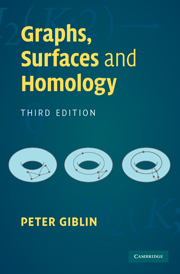Book contents
- Frontmatter
- Contents
- Preface to the third edition
- Preface to the first edition
- List of notation
- Introduction
- 1 Graphs
- 2 Closed surfaces
- 3 Simplicial complexes
- 4 Homology groups
- 5 The question of invariance
- 6 Some general theorems
- 7 Two more general theorems
- 8 Homology modulo 2
- 9 Graphs in surfaces
- Appendix: abelian groups
- References
- Index
1 - Graphs
Published online by Cambridge University Press: 05 June 2012
- Frontmatter
- Contents
- Preface to the third edition
- Preface to the first edition
- List of notation
- Introduction
- 1 Graphs
- 2 Closed surfaces
- 3 Simplicial complexes
- 4 Homology groups
- 5 The question of invariance
- 6 Some general theorems
- 7 Two more general theorems
- 8 Homology modulo 2
- 9 Graphs in surfaces
- Appendix: abelian groups
- References
- Index
Summary
The theory of graphs, otherwise known as networks, is a branch of mathematics which finds much application both within mathematics and in science. There are many books where the reader can find evidence to support this claim, for example those by Berge, Gross & Yellen, Diestel, Wilson & Beinecke and Bollobás listed in the References. Our motivation for touching on the subject here is different. Many of the ideas which we shall encounter later can be met, in a diluted form, in the simpler situation of graph theory, and that is the reason why we study graphs first. The problems studied by graph theorists are usually specifically applicable to graphs, and do not have sensible analogues in the more general theory of ‘simplicial complexes’ which we shall study. It is hardly surprising, therefore, that the theory we shall develop has little to say of interest to graph theorists, and it is partly for this reason that an occasional excursion is made, in this chapter and elsewhere, into genuine graph-theoretic territory. This may give the reader some idea of the difficult and interesting problems which lie there, but which the main concern of this book, namely homology theory, can scarcely touch.
Abstract graphs and realizations
A graph is intuitively a finite set of points in space, called the vertices of the graph, some pairs of vertices being joined by arcs, called the edges of the graph.
- Type
- Chapter
- Information
- Graphs, Surfaces and Homology , pp. 9 - 37Publisher: Cambridge University PressPrint publication year: 2010
- 2
- Cited by



